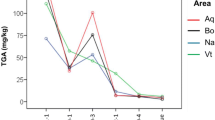Summary
Field experiments with four potato cultivars showed that there were significant differences in susceptibility to attack by wireworm,Agriotes obscurus. The two most susceptible cultivars had the lowest total glycoalkaloid (TGA) contents. Laboratory experiments with wireworms feeding on tuber slices demonstrated that regions characterized by a low sugar and a high glycoalkaloid concentration were avoided as feeding sites. Bio-assays with glycoalkaloids also showed that paper discs treated with a mixture of solanine and chaconine were avoided by wireworms.
According to a forward stepwise regression analysis based on data from four cultivars and six regions of the tuber. TGA was the key factor in predicting larval feeding, accounting for 65% of the total variation. Differences in reducing sugar levels (fructose + glucose) explained an additional 13% of the variation. Differences in chlorogenic acid and sucrose levels added very little to the accuracy of the prediction.
Similar content being viewed by others
References
Ågren, L., 1986. Adult phenology ofAgriotes (Coleoptera, Elateridae) on the Baltic island of Öland.Entomologisk Tidskrift 107: 47–50.
Brown, J., G.R. Mackay, H. Bain, D.W. Griffith & M.J. Allison, 1990. The processing potential of tubers of the cultivated potato,Solanum tuberosum L., after storage at low temperatures. 2. Sugar concentration.Potato Research 33: 219–227.
Burton, W.G., 1989 The Potato-3rd ed., Longman Scientific & Technical, Harlow, UK, 742 pp.
Bushway, R.J., A.A. Bushway & A.M. Wilson, 1981. α-chaconine and α-solanine content of MH-30 treated Russet Burbank, Kathadin, and Kennebec tubers stored for nine months at three different temperatures.American Potato Journal 58: 498.
Crombie, A.C. & J.H. Darrah, 1947. The chemoreceptors of the wireworm (Agriotes spp.) and the relation of activity to chemical constitution.Journal of Experimental Biology 24: 95–109.
Hansen, V., 1964. Fortegnelse over Danmarks biller (Coleoptera).Entomologiske Meddelelser 33: 1–507.
Hasegawa, S., R.M. Johnson & W.A. Gould, 1966. Effect of cold storage on chlorogenic acid content of potatoes.Journal of Agricultural and Food Chemistry 14: 165–169.
Hellenäs, K.-E., 1986. A simplified procedure for quantification of potato glycoalkaloids in tuber extracts by h.p.l.c.; comparison with ELISA and a colorimetric method.Journal of the Science of Food and Agriculture 37: 776–782.
Hsiao, T.H. & G. Fraenkel, 1968. The role of secondary plant substances in the food specification of the Colorado potato beetle.Annals of the Entomological Society of America 61: 485–493.
Kogan, M. & R.D. Goeden, 1971. Feeding and host-selection behavior ofLema trilineata daturanaphila larvae (Coleoptera: Chrysomelidae).Annals of the Entomological Society of America 64: 1435–1438.
Koch, H.A., 1960. Untersuchungen über die Wirkung von Insektiziden und von Pflanzenalkaloiden auf dem Darmtraktus des Kartoffelkäfers und seine Larven.Entomologia Experimentalis et Applicata 3: 103–113.
Mapson, L.W., T. Swain & A.W. Tomalin, 1963. Influence of variety, cultural conditions and temperature of storage on enzymatic browning of potato tubers.Journal of the Science of Food and Agriculture 14: 673–684.
Morris, S.C. & J.B. Petermann, 1985. Genetic and environmental effects on levels of glycoalkaloids in cultivars of potato (Solanum tuberosum L.).Food Chemistry 18: 271–282.
Nilsson, C., 1972. Knäpparlarvskador på vårsådda stråsädesgrödor.Växtskyddsnotiser 36: 67–69.
Rawlins, W.A., 1943. Some varietal differences in wireworm injury to potatoes.American Potato Journal 20: 156–158.
Richards, O.W. & R.G. Davies, 1977. Imm's General Textbook of Entomology-10th ed., vol. 1, Chapman and Hall Ltd, London, 418 pp.
Roddick, J.G., A.L. Rijnenberg & S.F. Osman, 1988. Synergistic interaction between potato glycoalkaloids α-solanine and α-chaconine in relation to destabilization of cell membranes: Ecological implications.Journal of Chemical Ecology 14: 889–902.
Ryan, J.D., P. Gregory & W.H. Tingey, 1982. Phenolic oxidase activities in glandular trichomes ofSolanum berthaultii.Phytochemistry 21: 1885–1887.
Sanford, L.L., K.L. Deahl, S.L. Sinden & T.L. Ladd Jr. 1990. Foliar solanidine glycoside levels inSolanum tuberosum populations selected for potato leafhopper resistance.American Potato Journal 67: 461–466.
Sanford, L.L., K.L. Deahl, S.L. Sinden & T.L. Ladd, Jr., 1992. Glycoalkaloid contents in tubers fromSolanum tuberosum populations selected for potato leafhopper resistance.American Potato Journal 69: 693–703.
Simpson, G.W., 1977. Potato insects and their control. In: O. Smith (Ed.), Potatoes: Production, Storing, Processing, 2nd ed., Avi Publishing Co., Westport, CT, USA, pp. 550–605.
Sokal, R.R. & F.J. Rohlf, 1969. Biometry, W.H. Freeman and Company, San Francisco, 776 pp.
Tingey, W.M., 1984. Glycoalkaloids as pest resistance factors.American Potato Journal 61: 157–167.
Voigt, J. & R. Noske, 1964. Zur Frage des Chlorogensäuregehaltes roher und gedämpfter Kartoffeln.Die Nahrung 8: 19–26.
Wierenga, J.M. & R.M. Hollingworth, 1992. Inhibition of insect acetylcholinesterase by the potato glycoalkaloid α-chaconine.Natural Toxins 1: 96–99.
Author information
Authors and Affiliations
Rights and permissions
About this article
Cite this article
Jonasson, T., Olsson, K. The influence of glycoalkaloids, chlorogenic acid and sugars on the susceptibility of potato tubers to wireworm. Potato Res 37, 205–216 (1994). https://doi.org/10.1007/BF02360510
Accepted:
Issue Date:
DOI: https://doi.org/10.1007/BF02360510




